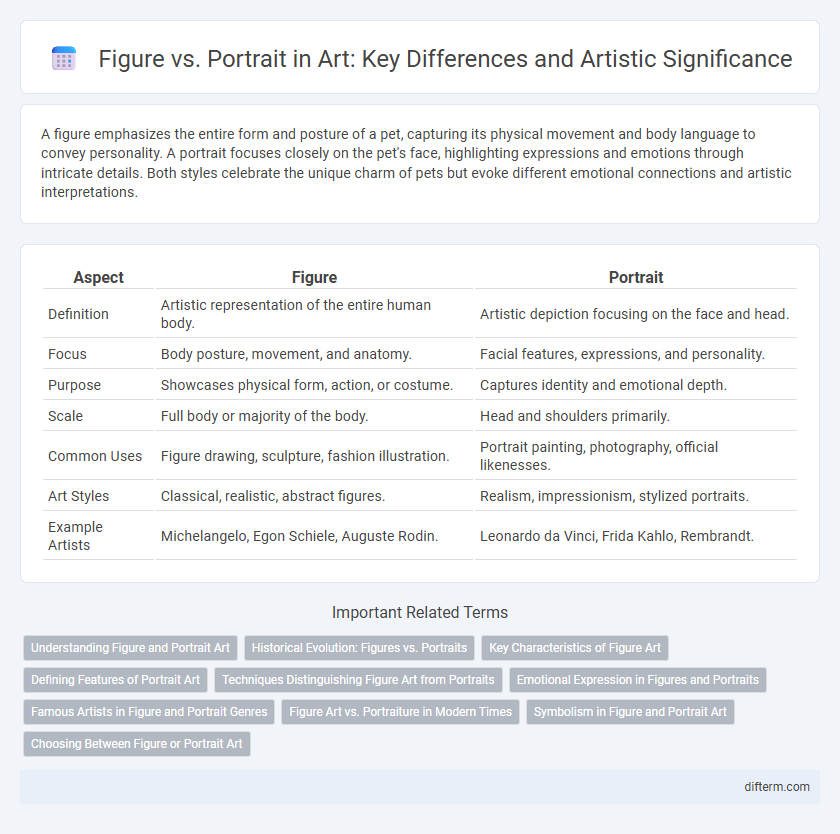A figure emphasizes the entire form and posture of a pet, capturing its physical movement and body language to convey personality. A portrait focuses closely on the pet's face, highlighting expressions and emotions through intricate details. Both styles celebrate the unique charm of pets but evoke different emotional connections and artistic interpretations.
Table of Comparison
| Aspect | Figure | Portrait |
|---|---|---|
| Definition | Artistic representation of the entire human body. | Artistic depiction focusing on the face and head. |
| Focus | Body posture, movement, and anatomy. | Facial features, expressions, and personality. |
| Purpose | Showcases physical form, action, or costume. | Captures identity and emotional depth. |
| Scale | Full body or majority of the body. | Head and shoulders primarily. |
| Common Uses | Figure drawing, sculpture, fashion illustration. | Portrait painting, photography, official likenesses. |
| Art Styles | Classical, realistic, abstract figures. | Realism, impressionism, stylized portraits. |
| Example Artists | Michelangelo, Egon Schiele, Auguste Rodin. | Leonardo da Vinci, Frida Kahlo, Rembrandt. |
Understanding Figure and Portrait Art
Figure art emphasizes the entire human form, capturing posture, anatomy, and movement to explore physical presence and expression. Portrait art focuses on depicting the face and personality, aiming to convey the subject's character, emotions, and identity. Mastery in figure and portrait art requires studying anatomy, light, shadow, and facial features to create lifelike and expressive representations.
Historical Evolution: Figures vs. Portraits
Figures depict the entire human form, often capturing dynamic poses and body language to convey narrative or emotion, while portraits focus primarily on the face to express individual identity and personality. The historical evolution from rigid, symbolic figures in ancient art to more realistic and psychologically complex portraits in the Renaissance reflects changing artistic priorities and advances in anatomical knowledge. By the 19th century, innovations like photography influenced figure and portrait art, emphasizing realism and personal expression through detailed representation.
Key Characteristics of Figure Art
Figure art emphasizes the depiction of the human body in various poses and movements, highlighting anatomical accuracy, proportions, and the natural flow of muscles. It often captures the entire body or significant portions, exploring form, posture, and gesture to convey emotion and narrative without focusing heavily on facial details. The primary goal is to study human anatomy and express dynamic physicality rather than create a detailed likeness of an individual, which is central to portrait art.
Defining Features of Portrait Art
Portrait art emphasizes capturing the defining features that reveal a subject's identity, personality, and emotional state through detailed facial expressions and posture. Unlike figure art, which prioritizes the entire human form and body language, portraiture centers on the face and upper body to convey individual character. Key elements include accurate anatomical proportions, expressive eyes, and subtle nuances in skin tone and texture, all contributing to a lifelike and intimate representation.
Techniques Distinguishing Figure Art from Portraits
Figure art emphasizes the entire human form, capturing posture, anatomy, and movement often through gestures and body dynamics, while portraits focus primarily on facial expressions and identity. Techniques in figure art include dynamic posing, anatomical precision, and the use of light and shadow to highlight musculature and form, contrasting with portrait techniques that prioritize fine detail, skin texture, and emotional nuance. Artists employ contour lines, proportion studies, and expressive brushstrokes in figure art to convey motion and volume, unlike the meticulous realism and focal framing typical of portraiture.
Emotional Expression in Figures and Portraits
Figures capture emotional expression through dynamic body language and posture, conveying moods and stories beyond facial details. Portraits emphasize subtle facial cues, using eyes, mouth, and skin texture to reveal inner emotions and personality. Both art forms harness visual elements to evoke profound emotional connections with the viewer.
Famous Artists in Figure and Portrait Genres
Famous artists like Leonardo da Vinci excelled in both figure and portrait genres, with works such as the Vitruvian Man showcasing anatomical precision and the Mona Lisa exemplifying portrait mastery. Auguste Rodin's sculptures emphasized dynamic human figures, capturing movement and emotion, while John Singer Sargent's portraits highlighted psychological depth and realism. These artists significantly influenced the representation of the human form by blending technical expertise with expressive detail.
Figure Art vs. Portraiture in Modern Times
Figure art emphasizes the entire human form, capturing movement, anatomy, and emotion through body language, while portraiture focuses primarily on facial expressions to convey identity and personality. In modern times, figure art explores abstract and dynamic compositions that challenge traditional representations, whereas portraiture often incorporates mixed media and psychological depth to reflect contemporary individuality. Both forms continue evolving, blending techniques to broaden the visual narrative of human experience in art.
Symbolism in Figure and Portrait Art
Symbolism in figure art emphasizes the representation of human bodies to convey abstract ideas, emotions, or cultural narratives beyond mere likeness. Portrait art prioritizes the individual's identity, using facial expressions and attributes to symbolize personality traits, social status, or psychological states. Both forms utilize symbolic elements, but figure art often abstracts the human form to express universal concepts, whereas portraiture anchors symbolism within personal and specific identity markers.
Choosing Between Figure or Portrait Art
When choosing between figure and portrait art, consider the emphasis on the human form versus individual identity; figure art highlights the body's movement, anatomy, and expression, while portrait art captures facial features and personality. Artistic intention often guides this decision, whether it's to explore dynamic poses or to convey emotional depth through facial detail. Understanding the purpose and emotional impact helps artists and collectors select the appropriate genre for their creative or curatorial goals.
figure vs portrait Infographic

 difterm.com
difterm.com